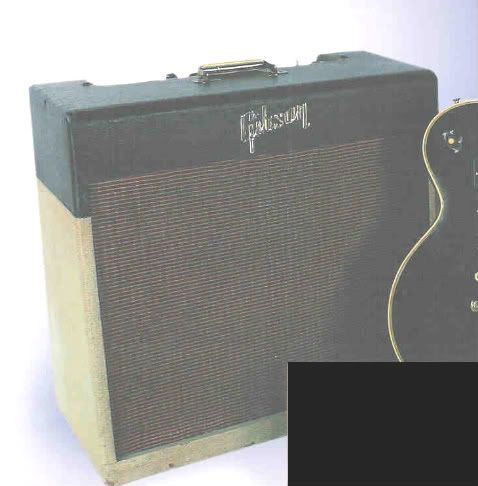Mr. Marx's Gibson book showed up today. It's divided roughly into 25% the origins of amplified sound, 25% Gibson corporate history and product development and 50% guide to Gibson amps. No punches are pulled when it comes to discussing Gibson's attitudes towards amps in general ("...not really musical instruments..."), Mr. McCarty's and Mr. Lover's attitudes towards the then-existing trends in music a/k/a R&R ("Jeez ... turn it down willya?"), and the rise of Fender ... which was driving the train seen leaving the station.
In its introduction to the guide to Gibson amps, the author reminds that there was: "... always room for variations and different configurations that we do not know about." and further "...If a certain model does not match the information here, please inform us so we an research it and include it in a possible revised edition in the future." (page 97) I can think of several misses and missteps but they aren't worth listing here. As a personal comment, I think the book spends too much time with the then top-of-the-line amps that nobody bought and apparently didn't sound very good and too little time on amp design and engineering and with the pretty neat 50s and 60s student models that they sold by the thousands and, thanks to some decent-enough engineering, have lasted until today and still sound pretty good.
The book was published by Blue Book Publications. It's interesting and informative ... sort of like the Blue Book of Acoustic Guitars. It doesn't offer itself as a history, only a 'guide'; it is more like the Blue Book and not a committed, scholarly history of Gibson of the type and intergrity of Hans Moust's book .... not even close. Finally, Mad Dog's late '50s two tone GA40LP made the cover ... maybe there's hope yet! (logo blocked out to avoid / evade Mr Moto Foto bouquet copyright police :evil: )

In its introduction to the guide to Gibson amps, the author reminds that there was: "... always room for variations and different configurations that we do not know about." and further "...If a certain model does not match the information here, please inform us so we an research it and include it in a possible revised edition in the future." (page 97) I can think of several misses and missteps but they aren't worth listing here. As a personal comment, I think the book spends too much time with the then top-of-the-line amps that nobody bought and apparently didn't sound very good and too little time on amp design and engineering and with the pretty neat 50s and 60s student models that they sold by the thousands and, thanks to some decent-enough engineering, have lasted until today and still sound pretty good.
The book was published by Blue Book Publications. It's interesting and informative ... sort of like the Blue Book of Acoustic Guitars. It doesn't offer itself as a history, only a 'guide'; it is more like the Blue Book and not a committed, scholarly history of Gibson of the type and intergrity of Hans Moust's book .... not even close. Finally, Mad Dog's late '50s two tone GA40LP made the cover ... maybe there's hope yet! (logo blocked out to avoid / evade Mr Moto Foto bouquet copyright police :evil: )




